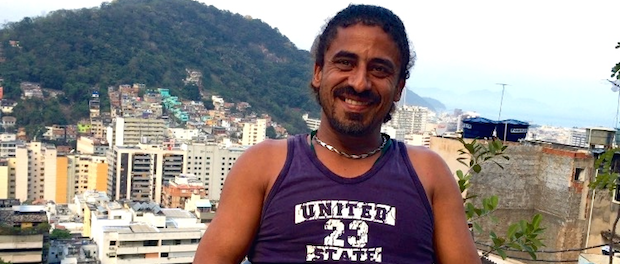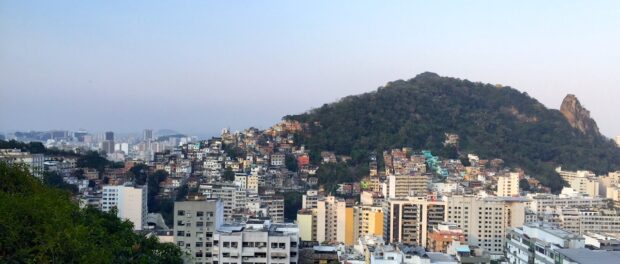
“It is a wonderful place, surrounded by nature, and it’s where I was born and raised and where I have my roots!” – Gilmar Lopes
Despite the negative stereotypes associated with life in the favelas, the reality is that the majority of residents are happy and are proud to reside in their communities. According to a study by Data Popular, 85% of residents like their home, 80% are proud of where they live, and 70% would continue living in their community even if their income doubled.
Gilmar Lopes was born and raised in Tabajaras and Morro dos Cabritos, favelas located in Copacabana in the South Zone of Rio. The official census reports that Cabritos has 5,000 residents but Gilmar says the Neighborhood Association estimates that the real population is between 16,000 and 18,000.
Gilmar has been connected to his community since childhood, forming many friendships when he collected and sold herbs in the market. He fell in love with an English woman at age 22 and moved to London where he lived and worked for 15 years.
Upon returning from London, Gilmar founded two organizations: Casa Eco Esportiva Sócio Cultural (CEESC) (Sociocultural Eco-sport House) and Tabritur. Tabritur is a community tourism company through which he guides groups of tourists around his favela. As he explains, Tabritur emerged from CEESC—a community space created to be rented for community and private events, in addition to meetings. We had the opportunity to interview Gilmar on his roof terrace to better understand why he chose to return to his life in Morro dos Cabritos and why the reality of life in the favela is so different from the stigmatized view from outside.
RioOnWatch: What are your first memories of living in Cabritos?
Gilmar: Water running down after the rain, because there was a little stream in front of my house and I always played with the pebbles. I think this was my first memory of Cabritos, but now I have a lifetime of memories from here.
RioOnWatch: Have you lived in Cabritos your whole life?
Gilmar: No. I lived in Cabritos, and I lived in London for 15 years. I went to London for a relationship I had, a passion. I stayed in London for 15 years and during those 15 years I worked in a buffet. I ended up staying in London due to a sense of adventure. But my goal was always to return home.
RioOnWatch: Why?
Gilmar: Because when I went to London, I already had a plan to return and do what I am doing!
RioOnWatch: Tell us more about CEESC.
Gilmar: CEESC Culture & Co. (Sociocultural and Eco-Sport House) is a personal achievement. I had the desire to create a mixed space where I could achieve economic stability while helping to resolve some of my community’s problems: offering courses, workshops, and social, cultural, and income-generating activities. These are the goals of CEESC. We already have a space and some national partners! Our current challenge is finding national and foreign partners that want to help us achieve our goals and transform CEESC into a place where people in our community can find opportunities.
RioOnWatch: And Tabritur—how did it start?
Gilmar: Tabritur originated through CEESC. Its function is to generate qualified opportunities for residents looking to provide a quality community tourism service. The tour is led by residents, backed by a study of the touristic potential of the community done in partnership with Sebrae [an organization that provides support to small businesses] in 2012 and 2013. It was determined that our community is ready to receive tourists, even though they believe that the government needs to do more for the community.
RioOnWatch: What is your view on tourism in the favelas?
Gilmar: Favela tourism is a form of inclusion in the city’s tourism circuit, generating income, opportunities and qualification for residents.
RioOnWatch: When is favela tourism productive? When is it not?
Gilmar: It’s productive when the income generated stays in the community, creating opportunities for residents! It is not when you do a “safari tour,” treating residents and their community like animals in a zoo!
Productive tourism depends on the intention of the visitor to get to know the environment and land which is new to him. When the guide is trained and qualified, he or she orients the tourist on what is appropriate to do in the community. For example, taking photos and places you can go. This guarantees the continuity of the project by the residents. A good guide has to be prepared to provide a quality service, for the tourist and for the community.
RioOnWatch: What is the impact of Tabritur on the community?
Gilmar: Its impact is enormous for residents, for local businesses, and for the city of Rio de Janeiro, producing quality tourism based on a study by Sebrae and Infnet [a private higher education institution in Rio].
RioOnWatch: Would you like to live in Cabritos for the rest of your life?
Gilmar: Yes, I would like to have my house in Cabritos for the rest of my life. To live, I want to live in many places in the world—it doesn’t mean that I can’t travel, even in Brazil. I haven’t seen many places in Brazil. There are many possibilities, but currently my life is in Cabritos and I am wonderfully happy here.
RioOnWatch: If you had the opportunity to live “on the asphalt” [in formal neighborhoods], would you leave Cabritos?
Gilmar: No, I left the asphalt to live in Cabritos. I had an apartment on Rua Pompeu Loureiro—one of the most coveted streets of Copacabana, residential, well located, with great access to the Lagoa. I sold that apartment to achieve this dream here to build CEESC.
RioOnWatch: What do you like about life in the favela?
Gilmar: The favela has good areas and areas that aren’t so good. I chose to live here because here I have peace, I have a view, I have silence, I have tranquility, and I have wonderful air. There is no pollution up here. The quality of life here in the favela, of our favela, is the reason I choose and prefer to live in the favela than in another place. And I was born and raised here. My friends, everyone is here. I don’t think I’ll ever stop living here. I can live somewhere else, but my home will always be here.
RioOnWatch: What is the culture of the favela like?
Gilmar: I love the culture we have here—samba, pagode, country life in the city. When you live inside the community, you play dominoes in the street. You can’t do this in the same way [on the asphalt]. Here we are in Copacabana, but on our main street you see people playing cards, playing dominoes, children running around freely. And today there is much less fear; people feel freer and more at ease. This is definitely also a factor that makes me like the favela even more. Now that we have peace, it is perfect.
RioOnWatch: So you are content with the Police Pacifying Unit (UPP)?
Gilmar: The UPP is part of a package the government promised the favelas. This package includes education, sanitation, mobility, and security. Only the UPP came [security]. Security now is much better—today fewer people die than before. Innocent or not is another story. Who can guarantee that before the UPP innocent people weren’t dying, but nobody knew? Now, if an innocent person dies, everyone knows. Journalists come, everyone comes in and says that an innocent person has died—it’s easy for the media to emphasize this now. It’s because of this we know about cases of innocent people being shot in the favelas. But who knows that before pacification this wasn’t happening and was overlooked because the media couldn’t get in?
RioOnWatch: Do you feel safe in the favela in comparison to the asphalt?
Gilmar: [I feel safer] than in Copacabana because in the favela I leave my door open. I leave the key to my motorcycle there and no one robs me. People who don’t know the favela think it’s dangerous. Those who know our favela know there’s no security problem. The problem of public security is one of Rio de Janeiro, not the favela. If the government enters a favela and doesn’t do what it should, it’s not the fault of the favela, it’s the fault of the government because it betrayed a place where people are normal—they pay their taxes, work, study, play sports, like music. They are normal! Why reject this place? You can be hit by a stray bullet in the favela or you can be hit by a stray bullet on the asphalt, on a bench in Copacabana, Ipanema, or Leblon.
RioOnWatch: What do you feel residents in general like about the favela?
Gilmar: People of the community like the peace, the sense of community. If you need sugar, you ask your neighbor; if someone is sick, immediately a bunch of people appear to take you to the hospital. We have this that creates a sense of community formed by people that live for one goal: the goal of social responsibility and association! When we are united, people are stronger. And if we are organized, we become much more intelligent! We will not be totally dependent on the government, which can’t even resolve its own problems, much less help and orient the people!
RioOnWatch: How can people interested in knowing more about your work with CEESC or do a tour with Tabritur contact you?
Gilmar: We are in partnership with ESPM producing the site www.CEESC.com.br and we have a Facebook page as CEESC Cultura & Cia. And by phone: +55-21-99369-2844.

